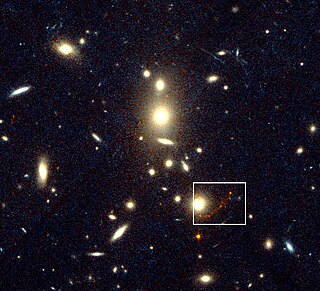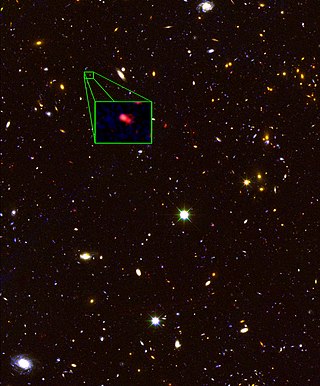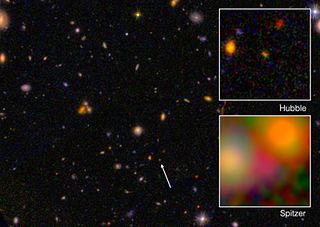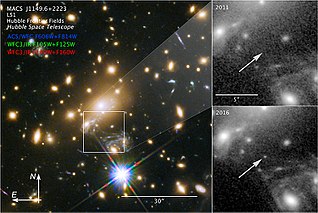
Galaxy groups and clusters are the largest known gravitationally bound objects to have arisen thus far in the process of cosmic structure formation. They form the densest part of the large-scale structure of the Universe. In models for the gravitational formation of structure with cold dark matter, the smallest structures collapse first and eventually build the largest structures, clusters of galaxies. Clusters are then formed relatively recently between 10 billion years ago and now. Groups and clusters may contain ten to thousands of individual galaxies. The clusters themselves are often associated with larger, non-gravitationally bound, groups called superclusters.

A quasar is an extremely luminous active galactic nucleus (AGN). It is sometimes known as a quasi-stellar object, abbreviated QSO. This emission from an AGN is powered by a supermassive black hole with a mass ranging from millions to tens of billions of solar masses, surrounded by a gaseous accretion disc. Gas in the disc falling towards the black hole heats up because of friction and releases energy in the form of electromagnetic radiation. The radiant energy of quasars is enormous; the most powerful quasars have luminosities thousands of times greater than that of a galaxy such as the Milky Way. Usually, quasars are categorized as a subclass of the more general category of AGN. The redshifts of quasars are of cosmological origin.

CL 1358+62 is a galaxy cluster located at z=0.33 redshift. Behind the cluster, lensed into a red arc is an infant galaxy that was the farthest object in the observable universe for a few months. It had a record redshift of z=4.92 and was discovered on July 31, 1997 by M. Franx and G. Illingsworth. It is located approximately 26 billion light years from Earth. Its redshift was measured by the Keck Telescope shortly after its discovery. Along with G1, another galaxy also lensed, was found to be at z=4.92. The pair of galaxies were the first things other than quasars to have the title of most distant object found, since the 1960s. The pair of galaxies remained the most distant objects known until the discovery of RD1 at z=5.34, the first object to exceed redshift 5.

HCM-6A is an LAE galaxy that was found in 2002 by Esther Hu and Lennox Cowie from the University of Hawaii and Richard McMahon from the University of Cambridge, using the Keck II Telescope in Hawaii. HCM-6A is located behind the Abell 370 galactic cluster, near M77 in the constellation Cetus, which enabled the astronomers to use Abell 370 as a gravitational lens to get a clearer image of the object.

GRB 090423 was a gamma-ray burst (GRB) detected by the Swift Gamma-Ray Burst Mission on April 23, 2009 at 07:55:19 UTC whose afterglow was detected in the infrared and enabled astronomers to determine that its redshift is z = 8.2, which makes it one of the most distant objects detected to date with a spectroscopic redshift.

UDFy-38135539 is the Hubble Ultra Deep Field (UDF) identifier for a galaxy which was calculated as of October 2010 to have a light travel time of 13.1 billion years with a present proper distance of around 30 billion light-years.

UDFj-39546284 is a high-redshift Lyman-break galaxy discovered by the Hubble Space Telescope in infrared Hubble Ultra-Deep Field (HUDF) observations in 2009. The object, located in the Fornax constellation, was identified by G. Illingworth, R. Bouwens and the HUDF09 Team during 2009 and 2010. It was reported with a redshift of z~10 using Hubble and Spitzer Space Telescope photometric data, with later reports in 2012 suggesting a possibly higher redshift of z = 11.9 Although doubts were raised that this galaxy could instead be a low-redshift interloper with extreme spectral emission lines producing the appearance of a very high redshift source, later spectroscopic observations by the James Webb Space Telescope's NIRSpec instrument in 2022 confirmed the galaxy's high redshift to a spectroscopically confirmed estimate of z = 11.58.

MACS0647-JD is a galaxy with a redshift of about z = 10.7, equivalent to a light travel distance of 13.26 billion light-years. If the distance estimate is correct, it formed about 427 million years after the Big Bang.

z8_GND_5296 is a dwarf galaxy discovered in October 2013 which has the highest redshift that has been confirmed through the Lyman-alpha emission line of hydrogen, placing it among the oldest and most distant known galaxies at approximately 13.1 billion light-years (4.0 Gpc) from Earth. It is "seen as it was at a time just 700 million years after the Big Bang [...] when the universe was only about 5 percent of its current age of 13.8 billion years". The galaxy is at a redshift of 7.51, and it is a neighbour to what was announced then as the second-most distant galaxy with a redshift of 7.2. The galaxy in its observable timeframe was producing stars at a phenomenal rate, equivalent in mass to about 330 Suns per year.

The galaxy cluster IRC 0218 hosts the most distant strong gravitational lensing galaxy currently known at a redshift of z = 1.62. The lens is one of the two brightest cluster galaxies and is lensing a background star-forming galaxy at a redshift of z = 2.26 into a bright arc and a faint counterimage. The lens was discovered through a combination of Hubble Space Telescope and Keck telescope imaging and spectroscopy. The discovery and subsequent analysis of the lens was published in the Astrophysical Journal Letters on June 23, 2014 by an international team of astronomers led by Dr. Kim-Vy Tran from Texas A&M University in College Station, Texas and team members Dr. Kenneth Wong and Dr. Sherry Suyu from the Academia Sinica Institute of Astronomy and Astrophysics in Taipei, Taiwan.

The XDCPJ0044.0-2033 (Gioello) galaxy cluster at redshift z=1.579 was discovered in the archive of the XMM-Newton mission, as part of the XMM-Newton Distant Cluster Project (XDCP) and first published by Santos et al. 2011. Gioiello is the most distant massive galaxy cluster that has been found and studied today. This massive galaxy cluster contains 400 trillion times the mass of the Sun and is located 9.6 billion light years away from Earth. The name Gioiello, meaning "jewel" in Italian, was given to this massive galaxy cluster because an image of the cluster contains many beautiful pink, purple, and red sparkling colors from the hot X-ray–emitting gas and other star-forming galaxies within the cluster.

EGSY8p7 (EGSY-2008532660) is a distant galaxy in the constellation of Boötes, with a spectroscopic redshift of z = 8.68, a light travel distance of 13.2 billion light-years from Earth. Therefore, at an age of 13.2 billion years, it is observed as it existed 570 million years after the Big Bang, which occurred 13.8 billion years ago, using the W. M. Keck Observatory. In July 2015, EGSY8p7 was announced as the oldest and most-distant known object, surpassing the previous record holder, EGS-zs8-1, which was determined in May 2015 as the oldest and most distant object. In March 2016, Pascal Oesch, one of the discoverers of EGSY8p7, announced the discovery of GN-z11, an older and more distant galaxy.

GN-z11 is a high-redshift galaxy found in the constellation Ursa Major. It was among the farthest known galaxies from Earth ever discovered. The 2015 discovery was published in a 2016 paper headed by Pascal Oesch and Gabriel Brammer. Up until the discovery of JADES-GS-z13-0 in 2022 by the James Webb Space Telescope, GN-z11 was the oldest and most distant known galaxy yet identified in the observable universe, having a spectroscopic redshift of z = 10.957, which corresponds to a proper distance of approximately 32 billion light-years.

MACS J1149 Lensed Star 1, also known as Icarus, is a blue supergiant star observed through a gravitational lens. It is the second most distant individual star to have been detected so far, at approximately 14 billion light-years from Earth. Light from the star was emitted 4.4 billion years after the Big Bang. According to co-discoverer Patrick Kelly, the star is at least a hundred times more distant than the next-farthest non-supernova star observed, SDSS J1229+1122, and is the first magnified individual star seen.

WHL0137-LS, also known as Earendel, is a star in the constellation of Cetus. Discovered in 2022 by the Hubble Space Telescope, it is the earliest and most distant known star, at a comoving distance of 28 billion light-years. The previous furthest known star, MACS J1149 Lensed Star 1, also known as Icarus, at a comoving distance of 14.4 billion light-years, was discovered by Hubble in 2018. Stars like Earendel can be observed at cosmological distances thanks to the large magnification factors involved, that can exceed 1000. Other stars have been observed through this technique, such as Godzilla.

HD1 is a proposed high-redshift galaxy, which is considered to be one of the earliest and most distant known galaxies yet identified in the observable universe. The galaxy, with an estimated redshift of approximately z = 13.27, is seen as it was about 324 million years after the Big Bang, 13.787 billion years ago. It has a light-travel distance of 13.463 billion light-years from Earth, and, due to the expansion of the universe, a present proper distance of 33.288 billion light-years.
F200DB-045 is a candidate high-redshift galaxy, with an estimated redshift of approximately z = 20.4, corresponding to 168 million years after the Big Bang. If confirmed, it would be one of the earliest and most distant known galaxies observed.















